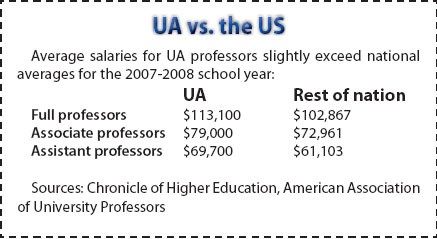While UA faculty salaries exceed national averages, the university is struggling to attract and maintain top employees.
According to data from the Chronicle of Higher Education, full-time professors at the UA will make an average of $113,100 during this school year, compared to $79,000 for associate professors and $69,700 for assistant professors.
All three figures exceed national averages for that span by $6,000 to $10,000, according to a report by the American Association of University Professors.
Still, the report states, salaries across the U.S. have struggled to keep up with inflation in recent years. The trend has led to high-quality faculty either leaving or avoiding the UA in favor of institutions offering premium wages, said Wanda Howell, a member of the Faculty Senate and a nutritional sciences professor.
The university had 2,805 total faculty members in the fall of 2007, according to data from the UA’s Office of Institutional Research and Planning Support.
“”When faculty are interviewed at other places and offered jobs, they’re offered salaries higher than they are receiving here, so it becomes an issue with maintaining quality faculty and being able to compete for top faculty,”” she said.
The reason faculty end up pursuing jobs at other institutions is due to a phenomenon called salary compression, said William Dixon, head of the political science department.
Under salary compression, new professors are hired for salaries that rise with the market, while existing professors don’t receive raises to keep their pay comparably competitive, he said.
“”Brand new Ph.Ds are making as much money as professors who have been around forever,”” Dixon said. “”Certainly, that’s a problem in my department, and I’m sure it is in others as well. There’s money available to hire new professors, but no funds to bring the existing ones up to national standards.””
Howell echoed a main point of the AAUP report in pointing out the salary divide between the different disciplines of higher education, such as between science faculty and humanities faculty.
The report also found that, on average, male faculty earn about 20 percent more than female counterparts.
When looking at individual jobs, men’s salaries were 7 to 10 percent higher than women’s.
“”Unfortunately, the female market has not caught up with the male market, and, unfortunately, we’ll work for less,”” Howell said.
Dixon said one explanation for the disparity is that men have traditionally held top jobs in academia, and women who are now closing the gap have started with more junior positions.
The report also emphasized the wide gap between the average salaries of university professors and presidents and other top administrators, as well as head coaches of NCAA Division I-A sports teams.
The report is available at www.aaup2.org/newsroom/press/2008/08z/zrep.htm.









